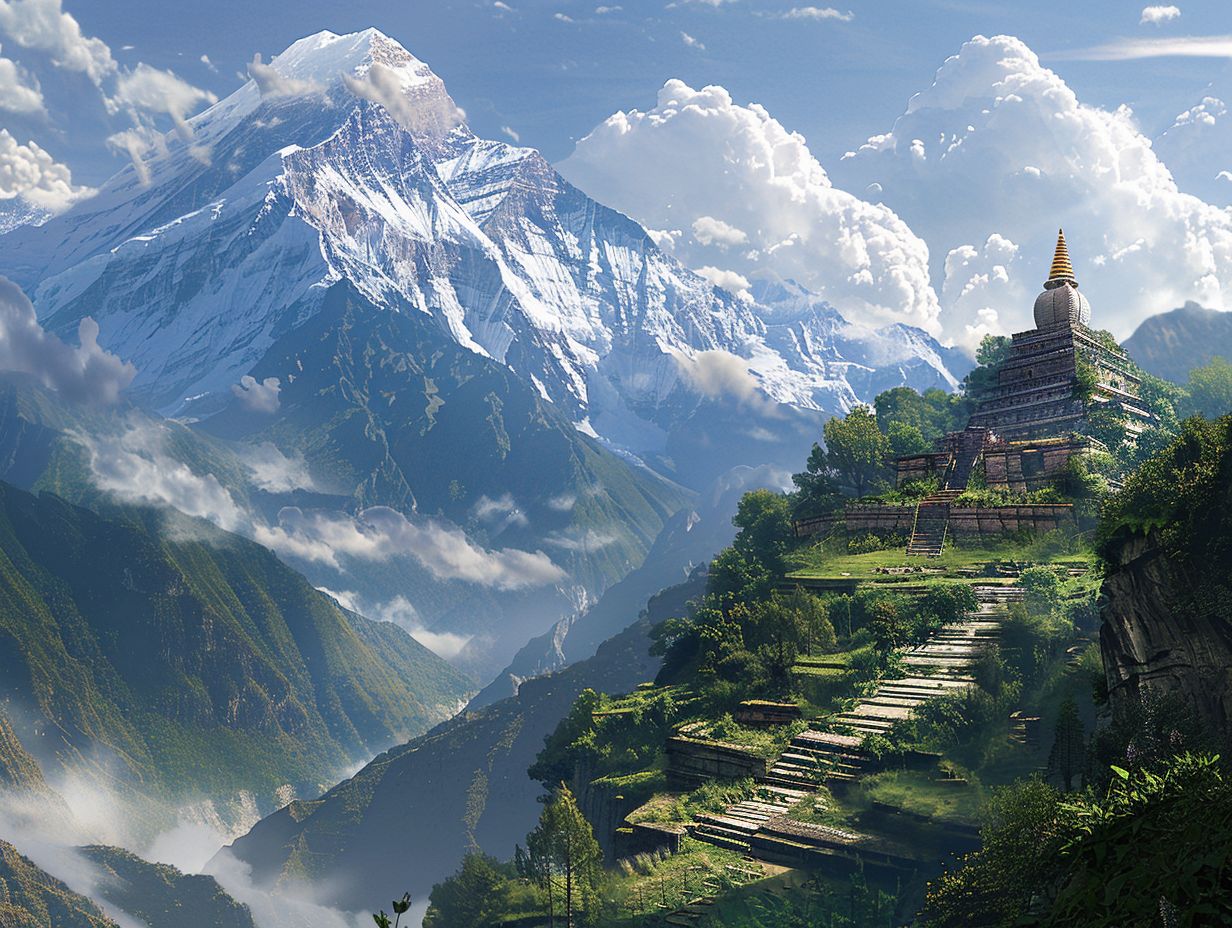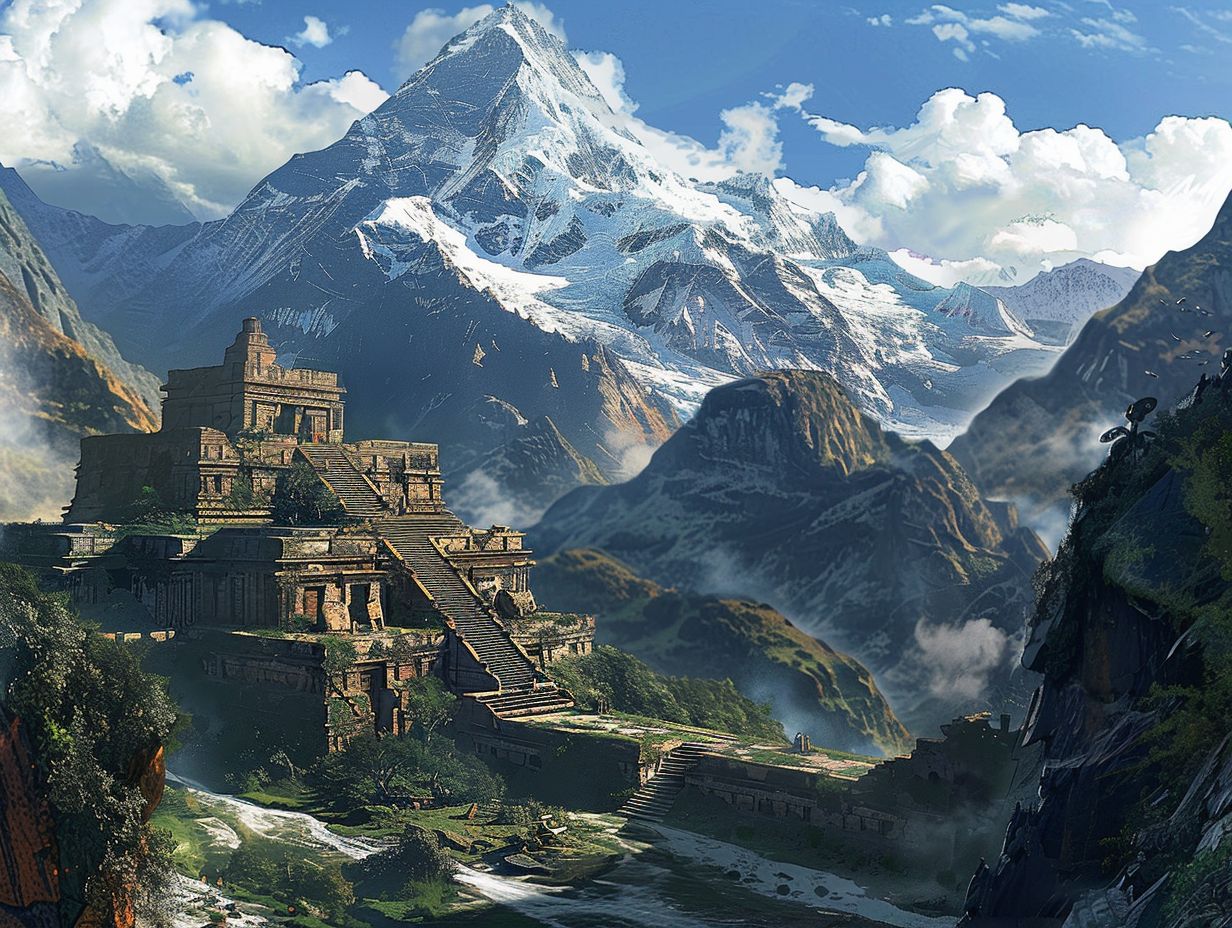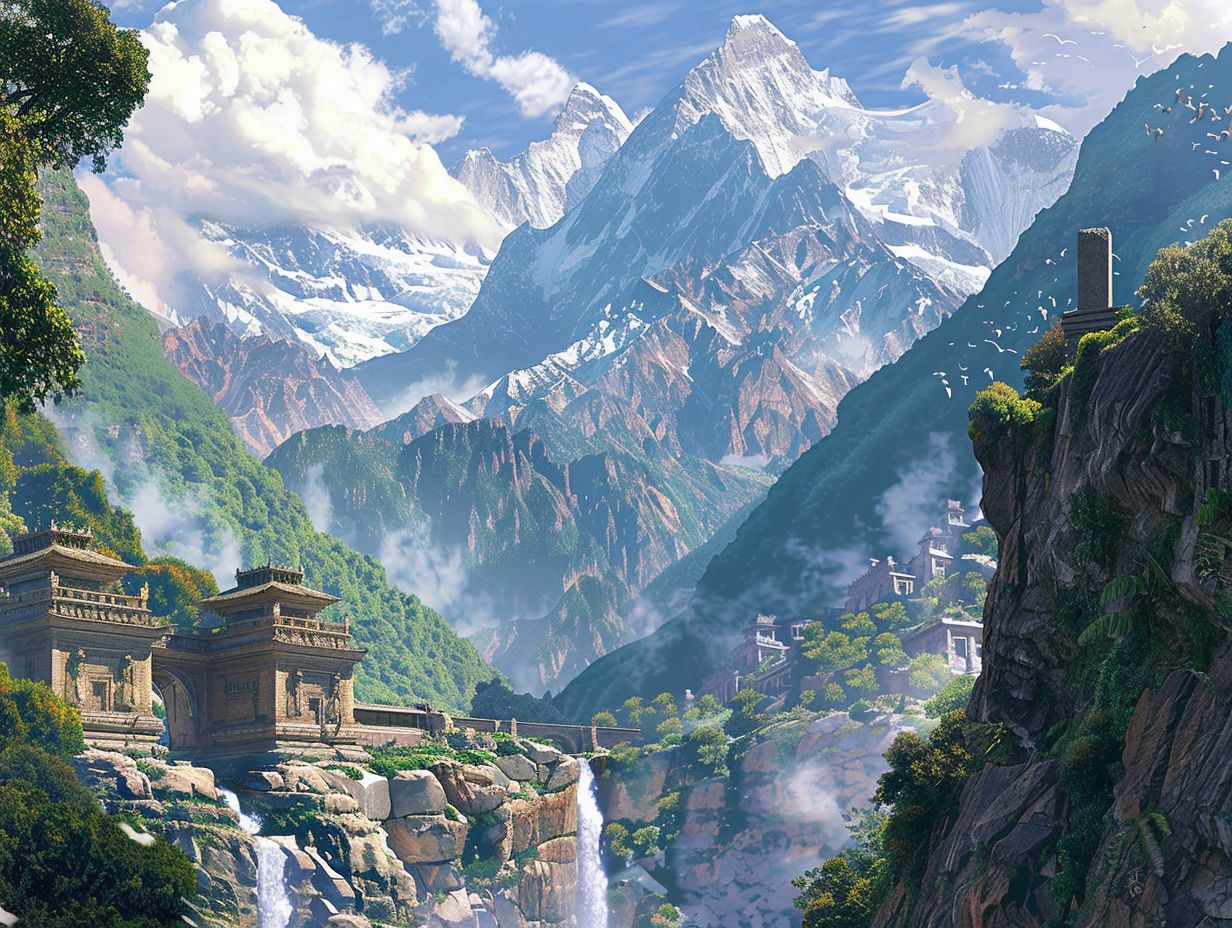
Kilimanjaro Vs Machu Picchu
Are you torn between trekking to Kilimanjaro or exploring Machu Picchu?
These iconic destinations offer unique geographical, cultural, trekking, and planning differences that cater to different preferences.
From the distinct locations and elevations to the rich histories and traditions, each destination has its own allure.
Join us as we compare the two, diving into the geographical landscapes, cultural significance, trekking experiences, and the costs and planning required for each adventure.
Key Takeaways:

- Kilimanjaro and Machu Picchu offer vastly different geographic landscapes, from the snow-capped summit of Kilimanjaro to the lush jungle of Machu Picchu.
- Both Kilimanjaro and Machu Picchu have rich cultural histories, with indigenous people and traditions that provide unique insights into their respective regions.
- Kilimanjaro and Machu Picchu treks vary in difficulty and duration, with options for every level of hiker, but both offer breathtaking views and unforgettable experiences.
Geographical Differences between Kilimanjaro and Machu Picchu:
Kilimanjaro and Machu Picchu are iconic destinations known for their distinct geographical features and natural beauty. While Kilimanjaro is a free-standing mountain in Africa, Machu Picchu is nestled in the Andes Mountains of Peru, offering different landscapes and elevations.
Each of these majestic locations presents a unique experience to visitors. Kilimanjaro, standing tall at approximately 5,895 meters, is part of the Kilimanjaro National Park and is surrounded by lush rainforests and diverse flora and fauna.
On the other hand, Machu Picchu, located at an altitude of around 2,430 meters, boasts ancient Incan ruins coupled with breathtaking views of the Urubamba River valley.
-
Location and Elevation:
The location and elevation of Kilimanjaro and Machu Picchu play a crucial role in defining their geographic diversity.
Kilimanjaro, part of the Kilimanjaro mountain range, is a dormant volcano with its snow-capped peaks standing prominently in the East African landscape. Its majestic presence dominates the surrounding savannah plains and forests, offering a stark contrast in elevation from the low-lying areas below.
On the other hand, Machu Picchu resides within the Andes mountain range, weaving its historical legacy with the stunning natural beauty of its surroundings. The lush greenery and misty atmosphere around Machu Picchu create a mystical aura, drawing travelers from around the world to explore this ancient Incan citadel.
-
Climate and Weather:
The climate and weather conditions of Kilimanjaro and Machu Picchu greatly vary due to their geographical locations and altitudes.
At Kilimanjaro, the temperatures can range from hot and humid at the base to freezing cold at the summit, thanks to its height and proximity to the equator. The mountain also experiences substantial precipitation, particularly during the wet seasons.
On the other hand, Machu Picchu benefits from its Andean setting, offering a milder climate with distinct wet and dry seasons. The rainy season from November to March makes the trails lush and vibrant, while the dry season from April to October provides clearer skies for picturesque views.
-
Vegetation and Wildlife:
The vegetation and wildlife surrounding Kilimanjaro and Machu Picchu showcase the diversity of ecosystems present in these regions. Kilimanjaro boasts lush jungles at its base, transitioning into alpine meadows and barren landscapes as climbers ascend towards the snow-capped peak.
On the other hand, Machu Picchu features rich flora and fauna, with dense forests and unique Andean wildlife species thriving in the mountainous terrain.
At the lower altitudes of Kilimanjaro, tropical rainforests are abundant, teeming with vibrant plant life such as tall trees, ferns, and orchids. As the elevation increases, visitors encounter heath and moorland zones with distinct vegetation like giant lobelias and senecios.
Meanwhile, Machu Picchu boasts diverse ecosystems across its varied altitudes, from cloud forests with moss-covered trees to grasslands dotted with native camelids such as alpacas and llamas.
Cultural Differences between Kilimanjaro and Machu Picchu:
The cultural distinctions between Kilimanjaro and Machu Picchu reflect the historical significance and heritage of these renowned sites.
Kilimanjaro, located in Tanzania, is not only Africa’s highest peak but also a site with deep cultural roots. The UNESCO World Heritage recognition of Kilimanjaro extends beyond its majestic slopes to encompass the traditions and customs of the Chagga and Maasai tribes.
These indigenous groups, known for their close connection to the land, have played a vital role in preserving the cultural integrity of the region.
On the other hand, Machu Picchu perched high in the Andes Mountains, offers a glimpse into the advanced engineering skills and spiritual beliefs of the Inca civilization. The intricate stone structures and agricultural terraces of Machu Picchu attest to the ingenuity of the Incan people, who revered the site as a sacred place of worship and ritual.
-
History and Origin:

The history and origin stories of Kilimanjaro and Machu Picchu offer insights into the rich cultural tapestries woven around these iconic landmarks.
Kilimanjaro’s legacy as a sacred site for local tribes dates back centuries, intertwining with folklore and spiritual beliefs. In comparison, Machu Picchu’s origins as an Inca citadel reveal the advanced engineering and architectural marvels of the Incan civilization, showcasing their strategic planning and cultural significance.
Legend has it that Kilimanjaro, Africa’s highest peak, was formed by the ancient gods to appease the earth. Each tribe surrounding Kilimanjaro holds unique stories about its creation, attributing mystical powers to the mountain.
On the other hand, Machu Picchu is believed to have been a royal estate or a sacred religious site for Inca rulers. Its sprawling terraces, temples, and astronomical observatories reflect the Inca’s deep connection to nature and the cosmos.
The intricate stonework at Machu Picchu is a testament to the Incan’s architectural ingenuity, where massive stones were transported and fitted together with remarkable precision without the use of mortar. This engineering feat demonstrates the Incan’s mastery of construction techniques and their respect for the natural landscape.
-
Indigenous People and Traditions:
The indigenous people and cultural traditions associated with Kilimanjaro and Machu Picchu enrich the historical tapestries of these world-famous destinations.
Local tribes like the Chagga community living near Kilimanjaro have a deep-rooted connection to the mountain, believing it to be a sacred entity that holds immense spiritual significance. Their traditional customs, passed down through generations, involve elaborate ceremonies and rituals that pay homage to the mountain and the spirits they believe reside within it.
On the other hand, Machu Picchu’s tie to the Inca civilization showcases the cultural heritage of the Andean people, with descendants of the Incas still practicing ancient rituals and ceremonies that date back centuries. At the heart of these traditions lies a sense of community celebration and reverence for the sacred sites that have defined their spiritual beliefs for generations.
-
Religious and Spiritual Significance:
The religious and spiritual significance attributed to Kilimanjaro and Machu Picchu transcends their physical landscapes, embodying a sacred connection to the divine for pilgrims and visitors alike.
Kilimanjaro’s towering presence has long been intertwined with intricate religious symbolism, believed to serve as a bridge between the earthly realm and the spiritual world. Various local tribes regard the mountain not merely as a geographical landform but as a conduit for divine energies and ancestral connections, fostering a deep sense of spiritual reverence.
In contrast, Machu Picchu’s intricate architectural layout and strategic positioning reflect the Incan cosmological beliefs, aligning with the movements of celestial bodies and serving as a sacred ground for communing with the divine. The site’s intricate stonework and sacred spaces evoke a sense of awe and wonder, reinforcing its status as a place of profound spiritual significance.
Trekking Differences between Kilimanjaro and Machu Picchu:
The trekking experiences between Kilimanjaro and Machu Picchu offer distinct challenges and adventures for hikers and trekkers seeking to conquer these legendary trails.
Kilimanjaro’s ascent involves navigating a range of terrains, from lush rainforests to alpine deserts, before reaching the snow-capped summit of Uhuru Peak.
The trek to Machu Picchu, in contrast, immerses adventurers in the ancient Inca civilization, as they traverse stone pathways, moss-covered ruins, and breathtaking mountain landscapes.
A key difference lies in the difficulty levels: Kilimanjaro’s altitude presents a significant challenge due to its elevation, while Machu Picchu’s trek is often known for its steep ascents and descents, testing endurance and agility.
-
Difficulty and Duration:
The trekking difficulty and duration on Kilimanjaro and Machu Picchu vary based on the chosen routes and altitude challenges encountered during the journeys.
In terms of Mount Kilimanjaro, trekkers need to navigate through various routes such as the popular Marangu and Machame routes, each with its own unique challenges. The strenuous ascent to Uhuru Peak involves adjusting to the altitude, with climbers advised to spend time acclimatizing at different camps along the way.
On the other hand, exploring the mystical paths leading to Machu Picchu offers a blend of historical richness and natural beauty as hikers traverse ancient Inca ruins and breathtaking mountain landscapes, all while acclimatizing to the high altitudes of the Andes.
- Altitude Challenges: Kilimanjaro’s Uhuru Peak stands tall at 5,895 meters, necessitating careful acclimatization to prevent altitude sickness; while Machu Picchu rests at around 2,430 meters, requiring visitors to adapt to the thinner air at high elevations.
- Trekking Durations: Climbing Kilimanjaro typically takes 5 to 9 days, depending on the chosen route, allowing for gradual altitude adjustment and strenuous hiking days, while the journey to Machu Picchu through the Inca Trail spans around 4 to 5 days, offering an immersive experience within the awe-inspiring Peruvian landscape.
-
Trail Options and Highlights:
The trail options and scenic highlights on Kilimanjaro and Machu Picchu present trekkers with unparalleled natural beauty and awe-inspiring landscapes along their respective routes.
Kilimanjaro offers trekkers a range of choices, such as the challenging Lemosho route known for its pristine wilderness and the lesser-traveled Rongai route, famed for its scenic views and a more gradual approach.
On the other hand, Machu Picchu’s diverse landscape includes the Salkantay trek, offering a less crowded alternative to the classic Inca Trail, with opportunities to traverse varying terrain from high altitudes to subtropical forests.
-
Accommodation and Facilities:

The accommodation options and facilities available on Kilimanjaro and Machu Picchu cater to the diverse needs of trekkers, offering varying levels of comfort and convenience during the trekking expeditions.
Kilimanjaro provides camping and mountain hut accommodations at different altitudes, ensuring shelter and basic amenities for climbers. Meanwhile, Machu Picchu offers a mix of camping and lodge stays along the Inca Trail, providing trekkers with comfortable resting spots amidst the Andean wilderness.
On Kilimanjaro, trekkers can opt for camping, immersing themselves in the raw beauty of the mountain, or choose mountain huts offering a more sheltered experience. These huts typically come with bunk beds, shared facilities, and fireplace for warmth.
In contrast, Machu Picchu’s lodge accommodations boast cozy beds, private rooms, and hot showers after a day of trekking. Both destinations ensure that trekkers have access to essential amenities such as clean water, basic meals, and experienced guides to navigate the trails smoothly.
Cost and Planning Differences between Kilimanjaro and Machu Picchu:

The cost and planning considerations for Kilimanjaro and Machu Picchu treks encompass various factors, including expedition expenses, health precautions, and safety measures to ensure a successful and enriching adventure for travelers.
In terms of trek costs, a Kilimanjaro expedition typically involves a higher financial investment due to the required permits and professional guides. In contrast, planning for a Machu Picchu trek involves considerations like altitude sickness medication and trail safety protocols for the rigorous mountain paths.
Health preparations for Kilimanjaro include physical fitness training and acclimatization efforts, while Machu Picchu trekkers need to anticipate the challenges of high altitudes and long hiking days. Safety guidelines for both destinations emphasize the importance of experienced guides, emergency evacuation plans, and adherence to environmental conservation practices.
-
Permits and Regulations:
Securing permits and adhering to trekking regulations are vital aspects of planning for Kilimanjaro and Machu Picchu adventures, ensuring compliance with national park rules and conservation guidelines.
For Kilimanjaro, the permit application process involves submitting necessary documentation, such as passport copies and itineraries, to the Tanzanian National Park Authority.
Upon receiving approval, trekkers can proceed with their journey, aware of the responsibility to minimize their environmental impact by carrying out all waste and leaving no traces behind.
Regarding Machu Picchu, visitors are required to book permits through authorized agencies or directly with the Ministry of Culture, indicating specific entry dates and durations.
Respecting the fragile ecosystems around these iconic sites is not only a legal requirement but also a moral obligation to preserve these natural wonders for future generations.
-
Equipment and Gear:
Selecting the right equipment and gear is essential for trekkers preparing for Kilimanjaro and Machu Picchu expeditions, ensuring safety, comfort, and readiness for the challenging terrains ahead.
For Kilimanjaro climbs, having proper high-altitude clothing is crucial to combat extreme cold and unpredictable weather conditions. Trekking poles serve as valuable aids, offering stability on rugged paths and reducing strain on the body during ascents and descents. Sturdy footwear with excellent ankle support is a must to navigate the rocky terrain and protect against twists and slips.
On the other hand, Machu Picchu hikers benefit from lightweight gear that allows freedom of movement while trekking through varying elevations and climates. Adequate rainproof apparel shields against sudden downpours and misty conditions commonly encountered along the Inca Trail, ensuring a dry and comfortable journey.
-
Travel Expenses and Logistics:
Managing travel expenses and logistical arrangements for Kilimanjaro and Machu Picchu excursions requires meticulous planning and budgeting to cover transport, accommodation, and additional activities like safaris or city tours. Kilimanjaro climbers should budget for flights, ground transportation, and trekking packages offered by tour companies to streamline their journey logistics.
Conversely, Machu Picchu travelers need to account for train tickets, bus transfers, and optional excursions to explore other Peruvian landmarks or cultural attractions beyond the ancient citadel.
For those embarking on a Kilimanjaro expedition, it’s essential to allocate funds for climbing permits, equipment rental, and gratuities for guides and porters. Considering the altitude challenges and physical demands of the trek, travelers might also benefit from budgeting for acclimatization days and medical supplies.
On the other hand, Machu Picchu visitors can optimize their budget by purchasing entrance tickets in advance and researching group tours or independent exploration options to suit their preferences. Budget-conscious individuals can also explore cost-effective accommodation choices in nearby towns for a more economical stay.
Frequently Asked Questions:
1. What is the difference between Kilimanjaro and Machu Picchu?
A: Kilimanjaro and Machu Picchu are two very different destinations with unique features and experiences. Kilimanjaro is a mountain located in Tanzania, Africa, and is known for its challenging trekking routes and breathtaking views. Machu Picchu, on the other hand, is an ancient Incan city in Peru that boasts impressive ruins and a rich history.
2. Which destination is more physically challenging, Kilimanjaro or Machu Picchu?
A: In terms of physical difficulty, Kilimanjaro is considered more challenging than Machu Picchu. The trek to the summit of Kilimanjaro can take anywhere from 5-9 days and requires a high level of fitness and acclimatization. Machu Picchu, on the other hand, can be reached by a 4-day trek or a more leisurely train ride.
3. What is the best time to visit Kilimanjaro and Machu Picchu?
A: The best time to visit Kilimanjaro is during the dry season, which runs from December to February and June to October. This is when the weather is most stable and the trekking conditions are at their best. For Machu Picchu, the dry season is from May to September, with July and August being the most popular months.
4. What type of accommodation is available at Kilimanjaro and Machu Picchu?
A: Kilimanjaro offers a range of accommodation options, including campsites, mountain huts, and luxury lodges. The type of accommodation will depend on the route you choose and your budget. Machu Picchu also has a variety of options, from basic hostels to luxury hotels located in nearby towns.
5. Can I visit both Kilimanjaro and Machu Picchu on the same trip?
A: Yes, it is possible to visit both Kilimanjaro and Machu Picchu on the same trip, but it would require a significant amount of time and planning. The two destinations are on different continents and require different travel arrangements. It is recommended to plan separate trips to fully experience each destination.
6. Which destination offers a better cultural experience, Kilimanjaro or Machu Picchu?
A: Both Kilimanjaro and Machu Picchu offer unique cultural experiences. Kilimanjaro is located in Tanzania, a country rich in culture and traditions.
The trek up the mountain will take you through various villages and give you the opportunity to interact with locals. Machu Picchu, on the other hand, is an ancient Incan city with impressive ruins and a rich history. Visitors can learn about the Incan culture and explore the ruins with a knowledgeable guide.